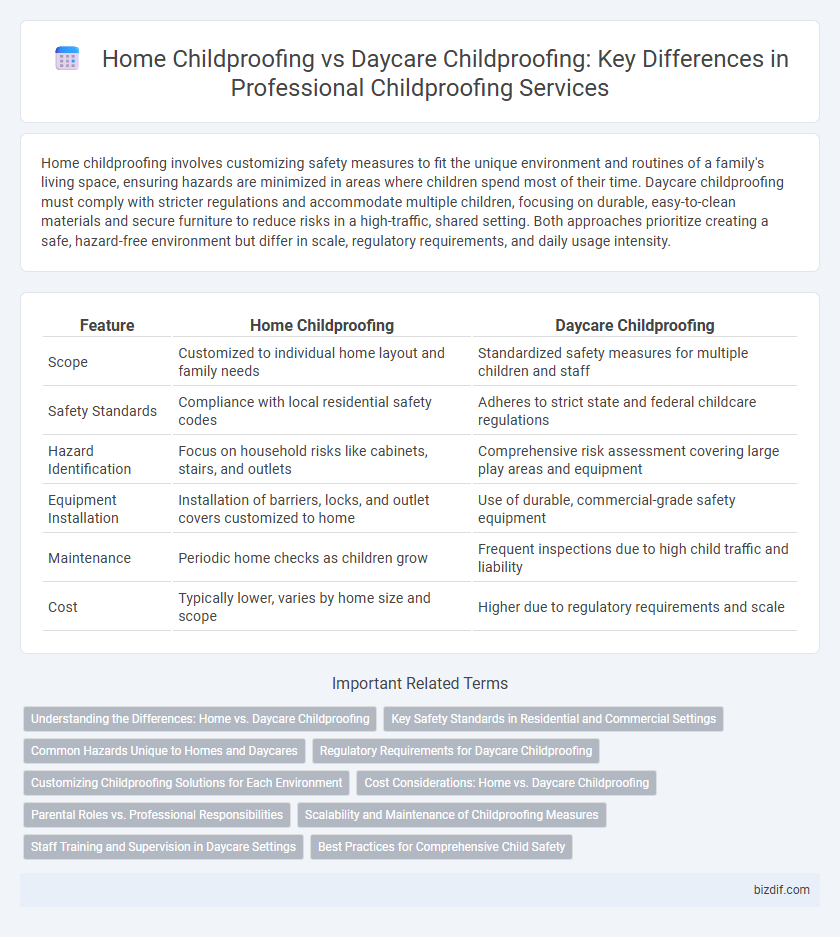Home childproofing involves customizing safety measures to fit the unique environment and routines of a family's living space, ensuring hazards are minimized in areas where children spend most of their time. Daycare childproofing must comply with stricter regulations and accommodate multiple children, focusing on durable, easy-to-clean materials and secure furniture to reduce risks in a high-traffic, shared setting. Both approaches prioritize creating a safe, hazard-free environment but differ in scale, regulatory requirements, and daily usage intensity.
Table of Comparison
| Feature | Home Childproofing | Daycare Childproofing |
|---|---|---|
| Scope | Customized to individual home layout and family needs | Standardized safety measures for multiple children and staff |
| Safety Standards | Compliance with local residential safety codes | Adheres to strict state and federal childcare regulations |
| Hazard Identification | Focus on household risks like cabinets, stairs, and outlets | Comprehensive risk assessment covering large play areas and equipment |
| Equipment Installation | Installation of barriers, locks, and outlet covers customized to home | Use of durable, commercial-grade safety equipment |
| Maintenance | Periodic home checks as children grow | Frequent inspections due to high child traffic and liability |
| Cost | Typically lower, varies by home size and scope | Higher due to regulatory requirements and scale |
Understanding the Differences: Home vs. Daycare Childproofing
Home childproofing involves customizing safety measures to fit a child's unique environment, addressing specific household hazards such as sharp furniture edges, accessible cleaning supplies, and unsecured electrical outlets. Daycare childproofing requires adhering to strict regulatory standards and accommodating a higher child-to-space ratio, focusing on durable safety equipment, comprehensive supervision systems, and universal hazard prevention across shared play and rest areas. Understanding these differences ensures tailored safety strategies that effectively protect children in both personalized home settings and communal daycare environments.
Key Safety Standards in Residential and Commercial Settings
Home childproofing emphasizes customizing safety measures to fit the unique layout and hazards of residential environments, including securing furniture, covering electrical outlets, and installing safety gates. Daycare childproofing adheres to stringent commercial safety standards, such as regulated fire exits, age-appropriate equipment, and constant supervision protocols, ensuring compliance with local licensing requirements. Both settings prioritize eliminating choking hazards, maintaining clean play areas, and using non-toxic materials to create safe spaces tailored to children's developmental needs.
Common Hazards Unique to Homes and Daycares
Home childproofing often requires addressing hazards such as unsecured cabinets, exposed electrical outlets, and household cleaning products within reach, which are less prevalent in daycare settings. Daycare childproofing focuses on managing group-related risks, including sanitized play areas, secure outdoor fencing, and safe furniture arrangements to accommodate multiple children simultaneously. Both environments necessitate tailored strategies to effectively minimize injuries specific to their unique layouts and usage patterns.
Regulatory Requirements for Daycare Childproofing
Regulatory requirements for daycare childproofing mandate compliance with strict safety standards set by state and federal agencies, including secure locks, smoke detectors, and safe play areas to prevent injuries. Daycare facilities must undergo regular inspections to ensure adherence to licensing regulations, such as child-to-staff ratios and emergency preparedness protocols. These regulations often surpass home childproofing measures, emphasizing comprehensive safety certifications and documented staff training in child safety practices.
Customizing Childproofing Solutions for Each Environment
Home childproofing requires tailored solutions that address unique household layouts and specific hazards, such as securing furniture, covering electrical outlets, and installing safety gates. Daycare childproofing focuses on creating safe communal spaces with durable, non-toxic materials, age-appropriate furniture, and fire safety measures to accommodate multiple children simultaneously. Customized childproofing ensures both environments meet safety standards while reflecting the distinct needs and activities of children in each setting.
Cost Considerations: Home vs. Daycare Childproofing
Home childproofing often entails upfront costs for safety gates, outlet covers, and cabinet locks, which vary based on the home's size and specific risks. Daycare childproofing typically involves higher expenditures due to regulatory compliance, professional-grade safety equipment, and ongoing maintenance. Comparing cost considerations reveals that home childproofing offers a one-time investment, while daycare settings require continuous spending to meet child safety standards.
Parental Roles vs. Professional Responsibilities
Home childproofing requires parents to continuously adapt their environment based on evolving developmental milestones, emphasizing personalized safety measures tailored to the family's lifestyle. In contrast, daycare childproofing involves professionals implementing standardized safety protocols to protect multiple children, ensuring regulatory compliance and managing group dynamics. The parental role centers on intimate knowledge and proactive adjustments, while daycare professionals focus on systematic risk management and consistent supervision within structured settings.
Scalability and Maintenance of Childproofing Measures
Home childproofing offers tailored safety solutions scalable to a family's specific needs, allowing easy adjustments as children grow and develop new abilities. Daycare childproofing requires comprehensive, durable measures designed for multiple children with varying behaviors, demanding frequent maintenance to ensure ongoing compliance with safety standards. Both environments benefit from regular inspections, but daycare settings necessitate more rigorous upkeep due to higher traffic and diverse usage.
Staff Training and Supervision in Daycare Settings
Daycare childproofing emphasizes rigorous staff training and continuous supervision to ensure children's safety in dynamic group environments, while home childproofing primarily focuses on securing physical hazards within a family setting. Trained daycare staff are equipped with knowledge in emergency response, child behavior, and safety protocols, which supports proactive hazard identification and mitigates risks more effectively than home environments typically allow. The structured supervision ratio in daycares also enables immediate intervention, enhancing overall child safety beyond what is achievable through home childproofing measures alone.
Best Practices for Comprehensive Child Safety
Home childproofing involves securing furniture, installing safety gates, and covering electrical outlets to create a hazard-free environment tailored to a child's daily living space. Daycare childproofing emphasizes compliance with regulatory standards, ensuring all toys and equipment are sanitized, age-appropriate, and free from choking hazards to protect multiple children in a shared setting. Combining both approaches maximizes child safety by addressing personalized risks at home and standardized precautions in group care environments.
Home Childproofing vs Daycare Childproofing Infographic

 bizdif.com
bizdif.com